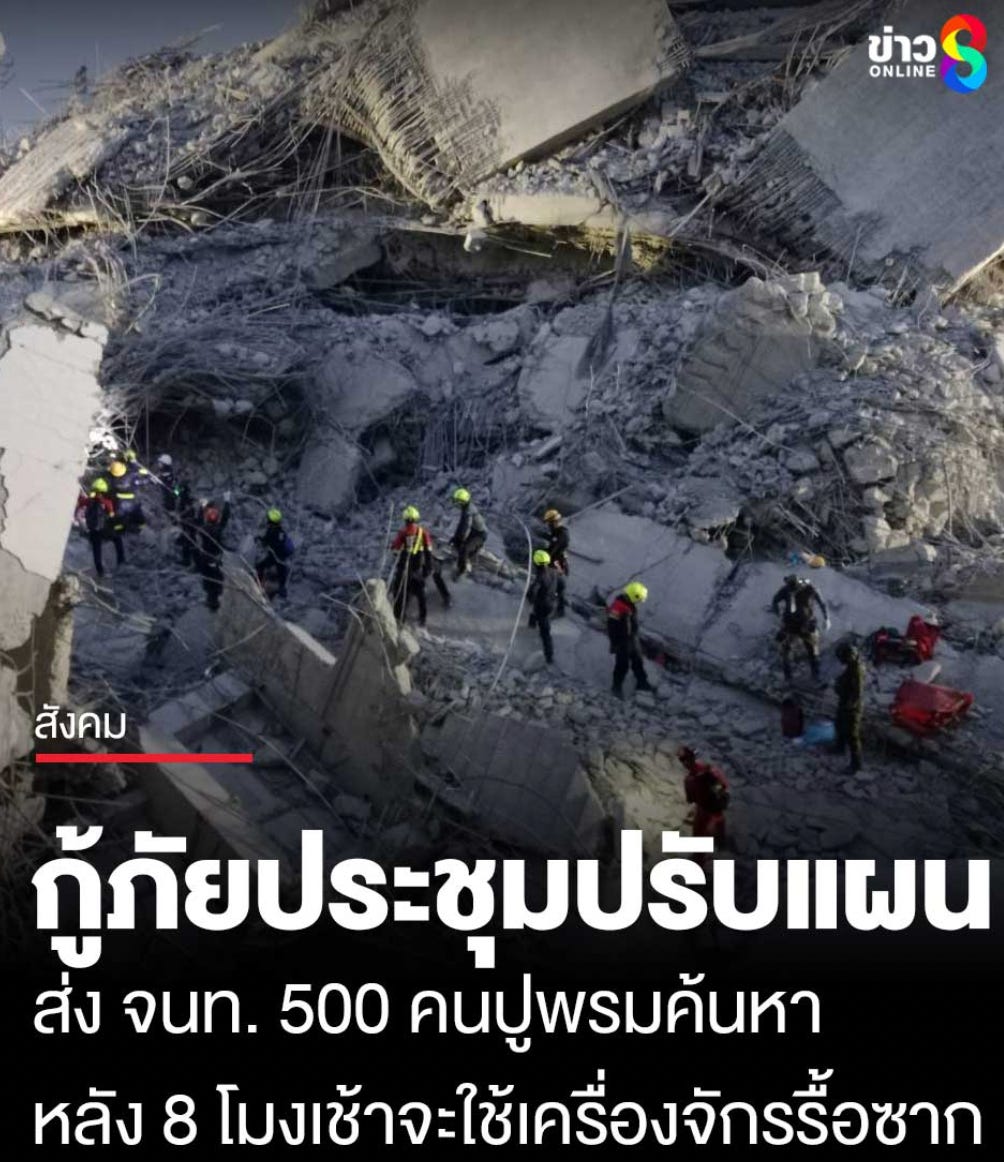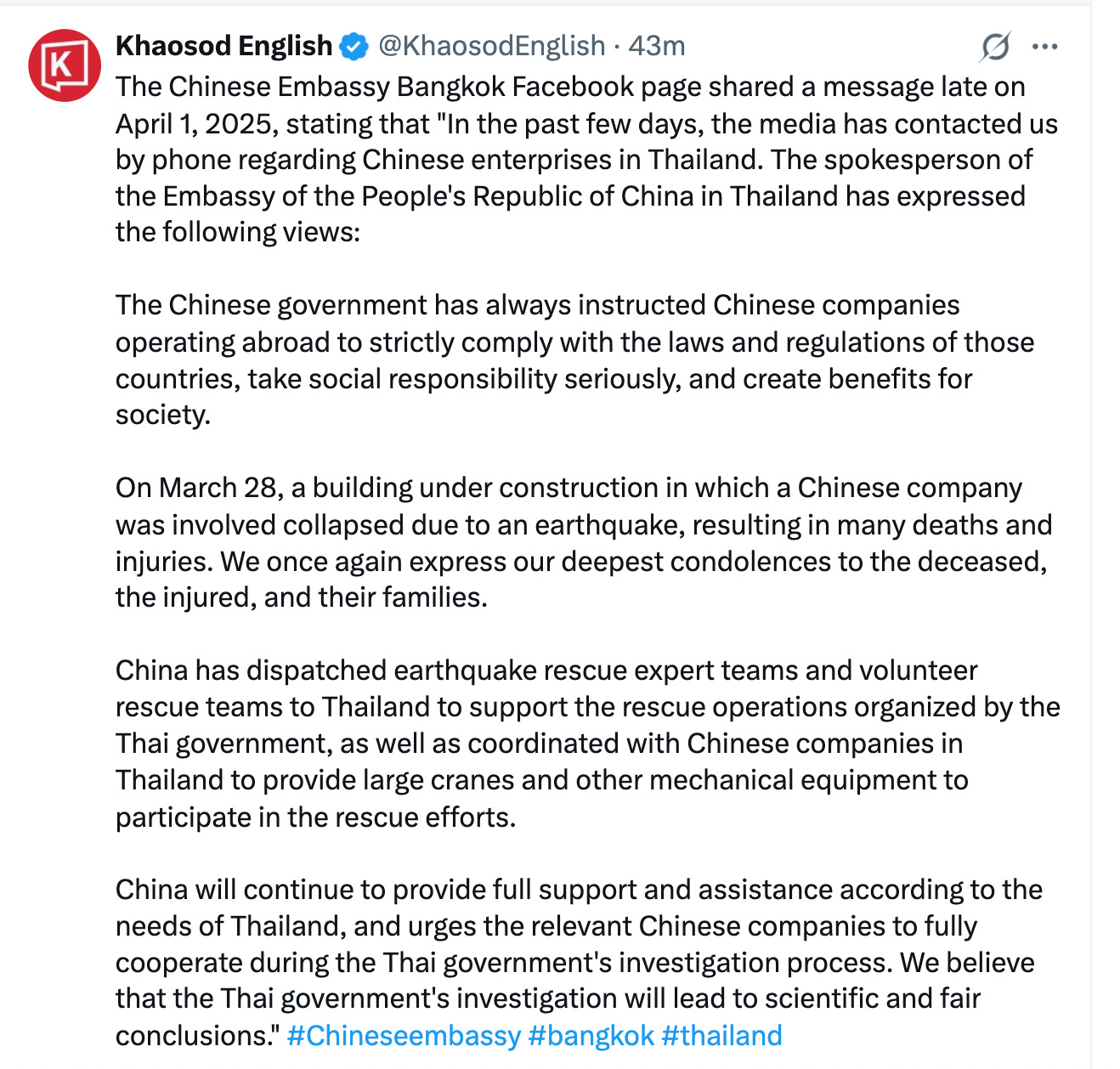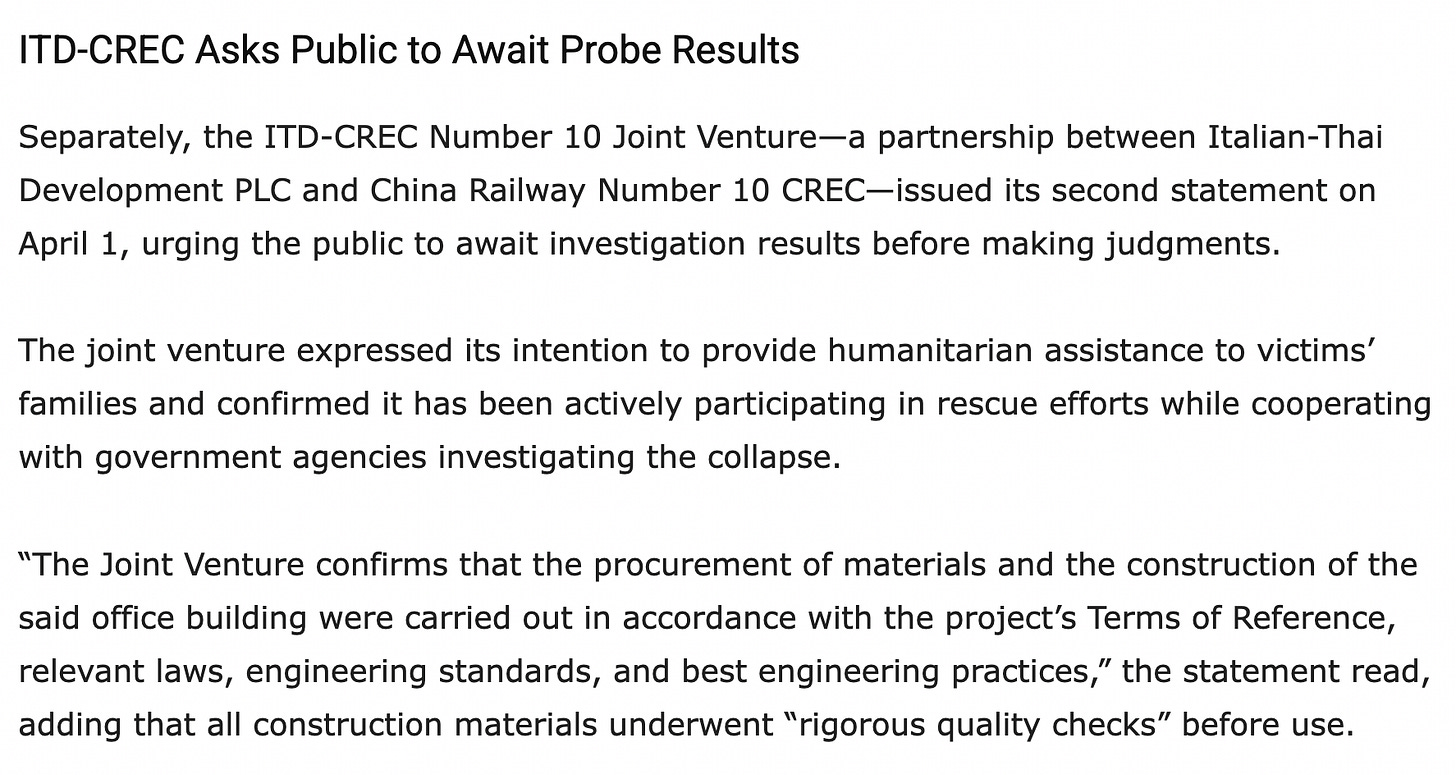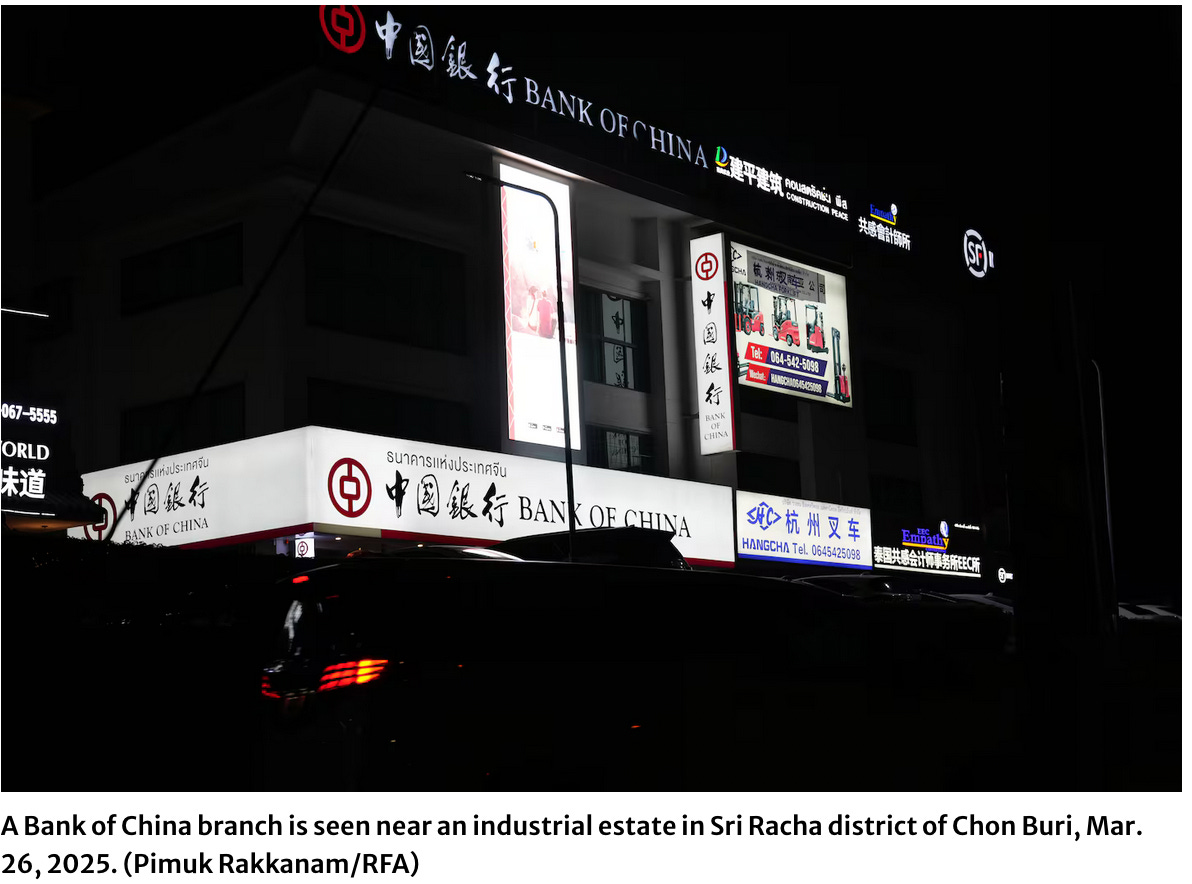THE THAI MEDIA STANDS UP!
Hopes fade for trapped workers as the vigil continues. 77 remain missing. .Meanwhile the Thai media speaks truth to power and goes into overdrive asking tough questions, searching for hard answers.
A review of the Thai media response to date on the 3.28 quake that rocked Bangkok and the tragedy of the collapsed State Audit building at Chatuchak
(Selected press updates included at end of this post for the period between April 3-April 6)
April 1
Hopes fade for dozens of trapped workers as the sad vigil by the wreckage of the building continues. Ten dead bodies have been recovered as of Sunday, another 77 workers are still unaccounted for. Meanwhile, the Thai media is in high dudgeon now, reporting on rescue efforts and asking tough questions and not taking boilerplate public relations statements at face value
PPTV is one of the several Thai TV news outlets aggressively looking into irregularities and inconsistencies in the ill-fated Audit Office Building project. A recent PPTV Thai-language report points out that CREC-related materials were deleted from the web in the last few days but traces of their corporate PR can be found elsewhere, including on the website of Goalfore, a Beijing-based advisory firm assisting Chinese enterprise abroad.
PPTV is also looking into irregularities on the Thai side of the State Audit building contract by which the routine inspection conducted by government anti-corruption authorities was apparently evaded from the beginning.
The Manager Online has a story about the China connections of Mr. Pisit Leelavachiropas, the former Auditor General of Thailand who holds an honorary Professorship from the Nanjing University of Auditing. The Manager also cites an AP report about China Railway’s Tenth Bureau being sanctioned by the US in 2020.
Suthithai Yoon, a veteran TV journalist, has addressed this and other questions in his regular Thai-language podcast, asking, “Who is going to audit the auditors?”
Matichon newspaper March 31 report on the discovery at the disaster site of steel bars of questionable quality, some traced to Xin Ke Yuan, a Rayong-based company with at least partial Chinese ownership.
Thai officials are looking into irregularities concerning the ITD-CREC No.10 joint venture, examining offices and demanding answers. Interior Minister Anuthin Charnvirakul had a meeting with Chinese ambassador Han Zhiqiang where they “pledged cooperation” in the investigation of the building collapse.
According to Khaosod English on March 31, the Office of the Auditor General released this information about some of the many parties involved in the project.
Building Design: Presented by FORUM ARCHITECT Co. Ltd. in 2018 and Meinhardt (Thailand) Ltd. (structural design) with a budget of 73 million baht. Construction: Budget of 2,560 million baht ($75.4 million), contracted to ITD-CREC (Italian-Thai Development Public Company Limited) joint venture with China Railway for 2,136 million baht ($62.9 million), below the median price. Payments of 966.80 million baht ($28.5 million) have already been disbursed. Supervision: Contracted to PKW Joint Venture for 74.65 million baht ($2.2 million) to supervise and certify material quality testing.

Thai PBS is another reputable news source that has been closely monitoring the case, dispatching journalists to the collapsed building zone and related corporate sites to comb for clues and look for answers. They caught footage of unidentified individuals, including four Chinese nationals who were questioned in a follow up police investigation suspected of removing evidence around the disaster site. Those accused of taking documents said it was for “insurance purposes.”
The four were booked on trespass-related charges, sentenced to two months and then apparently released on bail.

Channel Three TV news reports on substandard steel which appears old and rusted
Channel 8 News says a team of 500 officials has been sent to inspect the rubble.
After 8 AM on April 1, machine excavation equipment will be used to clear the site.
PRACHATHAI: Update on China Railway No. 10 (Thailand)
“According to the Thai Department of Business Development, Chinese national Zhang Chuanling holds 49% of the shares, the maximum foreign ownership allowed in a Thai company. The remaining shares are held by Thai nationals: Sophon Meechai (40.80%), Prachuab Sirikhet (10.20%), and Manas Sri-anant with just 3 shares.
China Railway No.10 Engineering Group Co. Ltd. also signed a contract valued at 9 billion baht for the Thai–China high-speed railway development (Bangkok-Nakhon Ratchasima), covering a total of 30 km. In 2019, the company took on the construction of the Office of the National Water Resources. This led to public speculation as the company was founded only in 2018, but won a government project with a value of nearly one billion baht the following year.
NATION:“4 Chinese caught fleeing with documents from SAO building, face charges”
“The 32 documents consist of various types of paperwork. During initial questioning, the four Chinese nationals claimed they entered the area to retrieve the documents for an insurance claim. The documents had been stored in a container serving as a temporary office for the company. The charges include unauthorized entry into a restricted area, which carries a penalty of up to three months in prison, a fine of up to 6,000 baht, or both. Police are also reviewing the seized documents to determine any connection to the building's collapse and will be questioning all relevant parties as part of the ongoing investigation.”
Some miscellany:
Portal for finding a job at China Railways Number Two in Thailand shows zero visitors:
A CREC 10 want-ad originally posted on or around March 28. The original is in Thai, here rendered roughly into English by Google Translate:
A similar ad, in the Thai original, looking for a Thai engineer to supervise water, electric and sanitation systems at a project in Phrae Province.
The English-language page for CREC News returns a “404 Not Found” at the moment.
A prolific poster on China-related matters on X found a CREC 10 sponsored article by Zou Wen singing praise of the superb construction techniques of the doomed State Audit building. The post has since been taken down:
https://qikanchina.com/thesis/view/8420027
“archived page in case the article is removed”
https://web.archive.org/web/2025032908
Excerpts of Zou Wen’s CREC report on the Audit Building design before it was taken off the internet. (Auto-translated from the original Chinese by Google Translate.)
4.1 Update on Thai media coverage of the ongoing rescue and investigation into the collapsed State Audit Building
Khaosod and other news sources, less than convinced by the self-exonerating statement, are taking a hard look at the Office of the Auditor General despite the boilerplate mea culpa above.
An excerpt of a follow-up statement by the Thailand State Auditor in response to unwanted media attention on irregularities in the commissioning, pricing and construction of the State Audit office building:
“Take a deep breath, hold hands tightly and take a step forward together.”
“In the face of criticism we feel is unfair, we will be patient, tolerant, avoid confrontation and refrain from retaliation against those with negative opinions.”








Thai Enquirer, a small but feisty web publication run by Cod Satrusayang has been on the story from the start, raising questions and pointing out irregularities ahead of the curve. The latest report enumerates 14 Thai government contracts with CREC 10 (China Railway No. 10 Engineering Group)
“China Railway No. 10 Engineering Group, a subsidiary of the Chinese state-owned China State Railway Group, secured 14 government contracts in Thailand worth 7.2 billion Baht between the 2019 and 2022 fiscal years….The “CSI LA” Facebook page revealed that China Railway No. 10 (Thailand) won several government construction projects by hiding the company name, such as the construction of the Minburi Criminal Court and the outpatient building at Songkhla Hospital…The investigation into China Railway No. 10 Engineering Group's alleged use of Thai nominees to hold shares has expanded to include 13 other linked companies and 4 others located in the same building as the company, according to Deputy Commerce Minister Napintorn Srisunpang.
While journalists write the first draft of history, public relations people are busy too. Thai tourism authorities, whose obsession with hotel revenue has prompted some executives to call for changing the current two-month tourist visa to one-month (because good tourists stay for a short time, spend a lot of money and leave) are now banging the drum about Bangkok being OK even while bodies are still being recovered.
The messaging is tone-deaf, especially at this time when much of the populace is upset about the quake, mourning lives lost in the wreckage of the State Audit building and angry about government corruption.
Below Bangkok governor Chatchart Sittipunt (in the middle) poses with foreign ambassadors and goodwill ambassadors two days after the quake to reassure tourists: “Bangkok we are OK!”
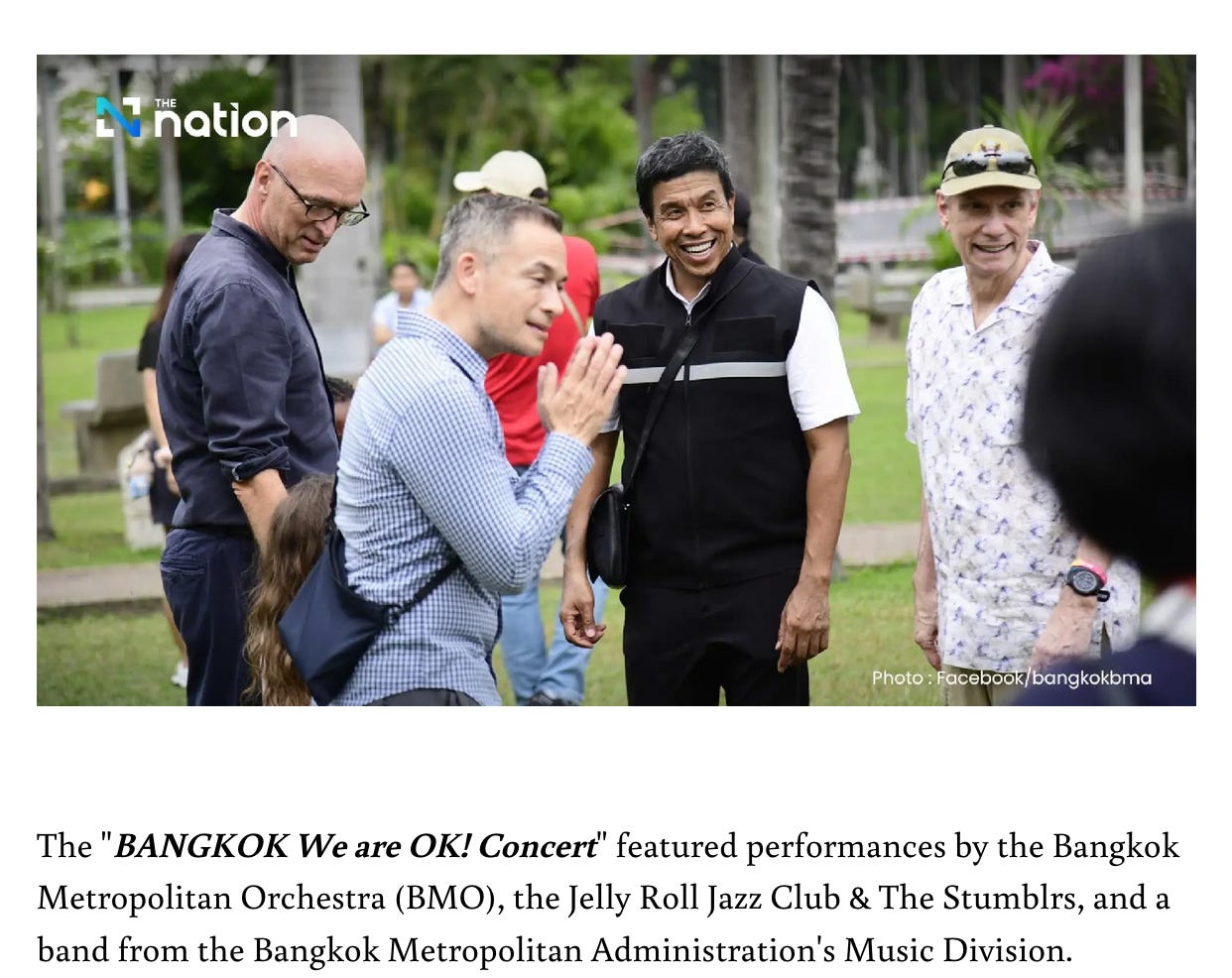
Not long after the above photo op Governor Chatchart was caught in a very sombre pose. Perhaps he got the memo that March 30 wasn’t the best time for a thumbs-up smiley campaign.
A quick course correction in image-making ensued.
Kudos to an alert cameraman who crafted this rather iconic follow-up photo. The solitary, grief-stricken governor is seen dejectedly observing the Chatuchak disaster scene from a respectful distance so as not to impede the urgent rescue efforts underway. Chatchart says he was tired, about to doze off, which rings true given the multipurpose role he plays in the wake of the disaster. Either way, a great PR shot.
By April 2, hard-hitting news in Khaosod was interspersed by PR statements issued by various stakeholders including the Chinese Embassy, the Thai Condo Association and the joint venture builders, ITD-CREC.
The Bangkok office of China Railway Number 10, which is said to have contracted for at least ten big projects in Thailand, (and by some reports as many as 29 projects worth 270 billion baht) is smaller the one might expect.
After some scrambling, the joint venture released a statement as follows:
What about ITD or Italthai?
The role of ITD or Italian-Thai, technically the majority partner in the joint venture, has been muted in the Thai press. This may reflect fear of libel in Thailand itself, for Italthai, as it is also known, (though family members have been known to quibble about who is responsible for what) It is one of Thailand’s construction giants.
The muted coverage also reflects that fact that the foreign angle on any story makes for juicier journalism, and the big China angle ties gets into fairly incendiary geopolitics as well. Finally, the dearth of reporting about Italthai is at least somewhat congruous with its apparently very limited role in the project (not that it doesn’t bear responsibility even if it just signed off on it and let China Railway run with it.)
As best can be determined at the current time, China Railways had actual control of the project, enhanced through the use of Thai nominees, and was responsible for implementing it.
Now in its third generation of Karnasuta family ownership, Italthai’s reputation has declined in recent years due to the failure of its gargantuan Dawai project in Burma, iffy finances, unpaid contractors, a high-profile poaching scandal and a spate of recent structural collapses on its Rama II road project.
Within days of the quake, corporate push-back and PR was being put out by vested interest groups such as the Thai Condominium Association, running its side of the “story” side-by-side with earthquake reports, with another example from Khaosod:
The head of the Thai Condominium Association confidently raised and answered ten questions about how condos are and aren’t affected by things like earthquakes.
In his PR pitch, Prasert drives home the point that “Thai citizens are incredibly fortunate to be protected by laws of such a high standard. These regulations ensure the long-term safety of life and property.”
Not a single life was lost in our country? It’s unlikely that Mr. Prasert meant that literally, rather he was thinking of his constituency. But in bending over backwards to reassure rattled condo owners, is it really necessarily to impugn the dignity of the 70-plus workers whose bodies are trapped in the rubble and probably now beyond hope of rescue?
China state related firm China Railway Number 110 is getting plenty of scrutiny, but it takes two to tango, maybe more. The Audit Office, whose official statements reek of arrogance, may be protesting innocence a bit too loudly.
4.3 Radio Free Asia
RFA ran a well-researched report by Pimuk Rakkanam that put a spotlight on the scale and scope of Chinese economic activity in Central and East Thailand, discussing the building collapse in context of complex network of Chinese firms in Chonburi.
4.4 Matichon:
A report in Matichon identifies China Railway Number 10 as having 29 projects in Thailand worth a whopping 270 billion baht.
4.5 Bangkok Post
“Can of worms opens at State Audit Office”
EDITORIAL : 5 Apr 2025 at 03:30
“The quake that brought down a building being constructed for the State Audit Office (SAO) late last month has opened a can of worms for an agency that preaches ethics.
Earlier this week, a list of expensive furniture that was claimed to have been in the collapsed building was exposed by the STRONG Anti-Corruption Thailand Facebook page, causing a stir.
The cost of furniture and fittings, including 28 meeting chairs at 97,900 baht apiece, seemed unusually expensive. These chairs were made from beech wood and upholstered in Italian leather. A set of leather-upholstered sofas priced at 157,000 baht was also lambasted for being overly luxurious. The agency also ordered 98 faucets costing 8,250 baht each, 98 soap dispensers priced at 1,668 baht each, and other bathroom accessories amounting to millions of baht.
The exposure -- like an aftershock -- has fueled public anger, with frowns all around over the way the SAO appears to have allowed misconduct and dubious practices in the construction project.
The agency has remained tight-lipped as the Department of Special Investigation (DSI) probes the blunder.
Critics have already slammed the proposed 30-storey height of the new SAO building. They believe the SAO, which stresses the need for austerity, did not need such a colossal building, which is now reduced to dust, in the first place.
What are deemed necessary luxuries in one context are in total contrast to how the SAO keeps strict control over state agencies' expenses.
In past years, state officials dealing with the SAO's complaints have earned it a reputation for being a fussbudget.
The affected officials said tight controls are unpractical and affect efficiency and morale.
Several officials in the education sector shared their thoughts on social media, with some recalling the case of an outstanding teacher who, out of goodwill, was dismissed from his job at a remote school in Chiang Mai because he expanded a subsidised lunch programme to cover older students who would otherwise have nothing to fill their stomachs. The SAO saw the inclusion of older students in the programme as a "misuse of school budget". The agency was also criticised for overreacting to a few missing receipts, without thinking that such documents are untypical in such a remote area.
One complainant said his project required out-of-the-box thinking -- something absent at the SAO, which upholds a culture of power, if not authoritarianism.
More importantly, the SAO appears unaware that extremely strict, irrational control, while compromising efficiency, can do little in curbing corruption. The agency does not need to look beyond itself to see that borne out.
Not to mention that the SAO still owes the public an explanation for the irregularities in the building project that resulted in heavy casualties. As of yesterday, there were 15 confirmed dead and 81 unaccounted for.
The most important point is that the SAO has been able to wield such a significant amount of power without oversight of any kind. That is something that must change.”
4.6 Khasod
April 6 update: Reports on the collapsed building story thinned out by April 3, and would likely have been entirely replaced by other stories, such as Trump wrecking the world economy by fat-headed fiat, were it not for the tragic fact that 77 people remain unaccounted for and are believed to still be buried in the rubble. The pile of rubble, a small rounded hill several stories in height, is prominently wedged between the popular tourist destinations of Chatuchak Market and the central train station. The disaster site, which already has a unique marking on Google Maps, is crowded with rescue vehicles and heavy equipment, alive with activity day and night as rescuers work against exponentially diminishing odds to find any signs of life.
The site is lit up bright at night to allow rescue work around the clock, a new and painfully unhappy addition to the list of weird and disconcerting things to see in Bangkok where tourism is key to bolstering economic livelihood in a lackluster economy.
April 6, Khaosod:
Khaosod reports: “Most recently, special case investigators visited Mr. Prajuab’s residence in Phon Sai district, Roi Et province, but only found his wife. She informed investigators that her husband earns very little, working as a construction laborer with a monthly salary of just over 10,000 baht ($290). Investigators noted this income is inconsistent with his shareholding in multiple legal entities, suggesting nominee arrangements.”
On April 6, the Chinese embassy departed from its terse, boilerplate statements to issue a disconcerting directive as reported and translated by Khaosod:
It’s quite a stretch, even for professional propagandists, to blankly state that “any information that does not correspond with the content published on the official website of the Embassy is false information” but that’s what they’re saying.
How many denizens of disaster-besmirched Thailand will be content to “rely solely on the content that matches” the official line of Embassy remains an open question. Even hard-core communist cadres are known to seek truth from facts from time to time (especially when such truth-seeking is permitted as a necessary corrective) and it’s unlikely the unease caused by this project, a project with as many layers of corruption as a rotten onion, is going to go away just because some zealous state officials are saying, “nothing to see here, look the other way.”
Finally, on a not-so-light note, popular tabloid newspaper Thai Rath has an ace cartoonist named Sia who deftly sums up widespread citizen qualms about the quake:



















